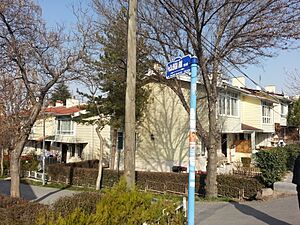Engin Arık facts for kids
Quick facts for kids
Engin Arık
|
|
|---|---|
| Born | October 14, 1948 |
| Died | 30 November 2007 (aged 59) Türbetepe, Keçiborlu, Isparta Province, Turkey
|
| Nationality | Turkish |
Engin Arık (born October 14, 1948 – died November 30, 2007) was a Turkish scientist who studied tiny particles. She was also a professor at Boğaziçi University. She led Turkey's involvement in many science experiments at CERN, a famous research center in Europe.
Engin Arık strongly believed that Turkey should be a full member of CERN. She also supported building a special center in Turkey to study particles. This center would help use a material called thorium as a new way to get energy. She also represented Turkey at a group that works to stop nuclear weapon tests. Sadly, she passed away in a plane crash on November 30, 2007.
Contents
Early Life and Learning
Engin Arık finished her first university degree in 1969 at Istanbul University. She studied both physics and mathematics. Later, she went to the University of Pittsburgh in the United States. There, she earned her master's degree in 1971 and her PhD in 1976.
Her PhD focused on experimental high energy physics. This means she did experiments to understand the smallest parts of matter and how they interact. She worked on an experiment at Brookhaven National Laboratory. After her PhD, she continued her research at the University of London. She also worked on high energy physics at the Rutherford Appleton Laboratory and later at CERN.
Her Work as a Scientist
In 1979, Engin Arık came back to Turkey. She joined the Physics Department at Boğaziçi University. She started as a lecturer and then became an associate professor in 1981. For a short time in 1983, she worked in a company called Control Data Corporation.
She returned to Boğaziçi University in 1985. By 1988, she became a full professor. While teaching, she continued her research in high energy physics. Even though there were not many resources for this type of research in Turkey, she kept going.
Working with CERN
In the early 1990s, she started working with scientists at CERN. She was part of several big experiments there. These included CHARM II, CHORUS, Spin Muon Collaboration (SMC), ATLAS, and CERN Axion Solar Telescope (CAST).
Engin Arık always wanted Turkey to be a full member of CERN. She believed this would help Turkish science a lot. She also cared about supporting women in science. She helped start the ATLAS Women's Network, which connects women working on the ATLAS experiment.
International Role and Thorium
From 1997 to 2000, Engin Arık represented Turkey. She worked with the Comprehensive Nuclear-Test-Ban Treaty Organization. This group meets at the International Atomic Energy Agency (IAEA) in Vienna, Austria. During this time, she traveled often between Geneva, Istanbul, and Vienna.
Engin Arık often talked about using thorium as an energy source. She believed it could power a new kind of nuclear power plant. She called thorium "the most strategic material of the 21st century." This shows how important she thought it was for the future.
Throughout her career, Engin Arık wrote over 100 scientific papers. These papers covered topics like experimental high energy physics, detectors, and how nuclear physics can be used. She was also the vice president of the Turkish Physical Society from 2001 to 2003. After she passed away, people remembered her as a leader in high energy physics in Turkey. They said she was like an "engine" for the science community.
Remembering Engin Arık
Engin Arık died in the Atlasjet Flight 4203 plane crash on November 30, 2007. She was traveling with two students and three other scientists. They were going to Isparta, Turkey for a meeting. The meeting was about designing a possible particle accelerator for Turkey.
After her death, a special scholarship was created at CERN in her memory. This scholarship helped 45 Turkish students attend CERN's Summer Student Program until 2015. Many organizations, people, and businesses helped fund this scholarship.
A big international meeting was held at Boğaziçi University in İstanbul in October 2008. It was held to remember Engin Arık and her colleagues. Another meeting happened three years later. It was organized by Doğuş University and Boğaziçi University, with help from CERN. In 2013, the main meeting room at the accelerator institute building was named after her. This building is now part of TARLA, the Turkish Accelerator Radiation Laboratory.
A street in Ankara, Turkey, has also been named after Engin Arık. At Süleyman Demirel University, there is a monument that remembers the six scientists who died in the plane crash. This monument includes a statue of Engin Arık.


